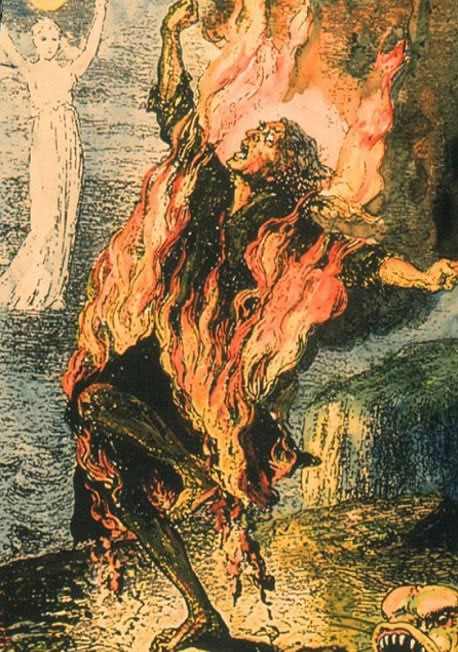Hypothesis of self-igniting
The history of more than 300 years recorded more than 200 cases of people suddenly burning to death, there was no sign of being burned by an external heat source.
- Decode real damage "phenomenon" who spontaneously ignited like a fireball
- Mysterious newborn baby ignites himself
- Mysterious phenomenon of the body burns itself
The mystery of a self-igniting person
The victims are often found alone in the house, with the head and body burning. However, the limbs were intact. In rare cases, organs are not damaged. The field room also did not detect burnt traces, in addition to a residue of grease on furniture and walls.
In 1641, the Danish physician, Thomas Bartholin (1616-1680), described the strange death of Polonus Vorstius - an Italian knight, in his book of strange diseases. In 1470, after drinking some strong alcohol, Vorstius began to vomit fire before it caught fire. This is considered the first case of self-igniting in human history.

The picture depicts the scene of the person igniting himself.(Photo: Public Domain)
In 1673, the French author Jonas Dupont also published a book on the study of Self-Igniting Cases (SHC) . One of the most famous cases in France was in 1725, when a Parisian landlord woke up and found his wife burnt to ashes, the corpse lying on a pad of straw. The mattress is intact, not burnt. Furniture around her was also intact.
All that remains of the wife, Mrs. Millet, a chronic alcoholic, is the skull, some vertebra and leg bones. The husband was initially suspected of killing his wife, but was later declared innocent, thanks to the testimony of a surgeon named Claude-Nicolas Le Cat. The doctor happened to stay at the inn that witnessed to the husband. The death of the landlord's wife was later declared to be "God's punishment".
SHC was well known in the 19th century, when the famous British writer Charles Dickens, used it to "kill" one of the characters in the Bleak House novel. Critics accused Dickens of describing things that did not exist, but he countered, pointing out that up to that time, there were 30 cases of SHC recorded.

Scene of characters caught fire in Bleak House novel.(Photo: Acient Origins)
Self-igniting victims often have the following characteristics: a chronic alcoholic, often a middle-aged woman, the fire causes very little damage to the surrounding objects, the body burns out a stench. uncomfortable.
There have been many theories about the cause of this phenomenon, such as fat in flammable bodies, accumulated acetone, static electricity, bacteria, methane and even God's intervention. The most commonly accepted cause of science is the "wick fiber effect".
If you consider the human body as a candle, then the fat in your body is candle wax, fuel for burning. Hair or clothes are wicks. If for some reason the clothes or hair catches fire, the fire will first burn the human skin. The fat under the skin will seep into the clothes and continue to become a fuel for burning.
This hypothesis can explain why only the body is burned, the area around the body and the limbs are less burnt. However, it cannot explain why this phenomenon occurs only indoors. No self-igniting incident took place on the street, near flammable sources. This phenomenon only occurs in humans, there are no reports of animal self-igniting. In addition, this hypothesis cannot explain why the victims were unmoving for the duration of the fire, as well as why the surrounding furniture is usually still intact. Moreover, in order to burn the victim to ash, a very high temperature is needed, about 1,648 degrees Celsius. The temperature in the crematorium is only about 982 degrees Celsius.

Hypothesis "fiber effect wick" .(Photo: Acient Origins)
SHC is not only recognized in ancient books, but also recorded in the modern world. In 2010 there was a case of spontaneous combustion in Ireland.
The body of an elderly man was burnt black, with his head near the fireplace. The room had almost nothing else burnt, both on the floor and the ceiling above the corpse. The Irish police investigation report concluded "self-igniting" was the cause of the 76-year-old's death.
Many people believe that the human body contains many unexplored things, one of which is the ability to self-ignite.
- Mysterious newborn baby ignites himself
- Decode real damage 'phenomenon' who ignites like a fireball
- Mysterious hands of self-igniting people
- Self-igniting bodies have no answers
- Answer causes some people to suddenly burn
- 'Wick fiber effect' in the phenomenon of people burning themselves into ash
- Test hypothesis 'Matrix'
- People suddenly caught fire, making medicine impossible to explain
- Video: Operation of a 2-stroke engine when viewed through the transparent cylinder cover
- Hypothesis of the past, present, future coexists in the universe
- Check the vacuum hypothesis
- History of Moon formation
 The truth about the mysterious red-haired giant at Lovelock Cave
The truth about the mysterious red-haired giant at Lovelock Cave Inunaki Tunnel: The haunted road leading into Japan's 'village of death'
Inunaki Tunnel: The haunted road leading into Japan's 'village of death' The mystery of the phenomenon of human reflection before dying
The mystery of the phenomenon of human reflection before dying 6 mysterious phenomena, although science has been developed for a long time, still cannot be answered
6 mysterious phenomena, although science has been developed for a long time, still cannot be answered